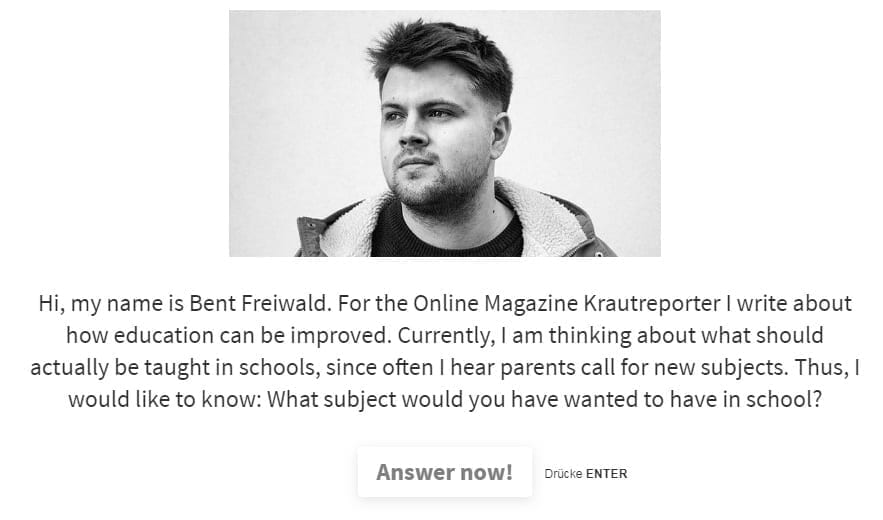|
Getting your Trinity Audio player ready...
|
Publishers use a variety of tools to drive engagement, including personalization, newsletters, and apps among others, but few make use of surveys.
Krautreporter, a member-funded magazine in Berlin, has found through an in-depth study of its members’ behavior that surveys can substantially boost engagement.
The findings are presented in a new playbook by European Journalism Centre’s Engaged Journalism Accelerator, an international non-profit that delivers grant funding, mentoring, resources etc. to support engaged journalism in European news organizations.
“The playbook builds on Engaged Journalism Accelerator’s mission to help create positive, more resilient and more impactful relationships between news organizations and their communities,” says Ben Whitelaw, Engagement Lead at Engaged Journalism Accelerator.
The study found that surveys can be a powerful tool for influencing members’ behavior and generating trust.
Here’s why:
- Survey engagement is not habitual unlike reading and commenting. Those who participate in surveys usually do so once in a while. Interviews with Krautreporter’s members revealed that they tend to participate when the topic is of interest to them. This means surveys create the opportunity for an out-of-habit experience related to a topic that a member cares about.
- Surveys have a sustainable effect on reading behavior. The study found that members who participate in a survey go on to display increased reading frequency till up to 4 weeks. This outperforms other engagement efforts at Krautreporter.
- Those who participate in at least 1 survey tend to stay members for, on average, 4 months longer. The closest that another touch-point comes to this is commenting on an article. It has a similar effect lasting for 3 months.
According to Leon Fryszer, author of The Engaged Journalism Playbook, other reader touch-points do not exhibit similar patterns. This led Krautreporter to build its engagement strategy focused on surveys.
Highlights from the playbook on how Krautreporter is implementing the strategy:
- Platform: The playbook recommends publishers to use an online survey platform that is mobile-friendly and enables them to set up surveys quickly. It should also integrate well with other tools the publisher uses. Krautreporter uses Typeform to set up surveys.
- Design: Broadly, surveys can be used to find out what matters to the readers, the topics they are interested in knowing more about, or specific angles on certain stories.
They can also be used to get readers’ views/insights for developing stories. Reporters at Krautreporter have come across valuable personal experiences of readers which they have used in their stories. Reader insights can be sought out for advice articles and listicles as well.
Make your survey an easy dialogue. It should feel like a conversation rather than like somebody is squeezing information out of members.
Leon Fryszer, The Engaged Journalism Playbook
Fryszer recommends creating short questionnaires that are fun to fill. Concrete questions work better compared to abstract or open ones. The purpose and topic of the survey should be given right at the beginning. And the first slide should carry the main question.
- Test: Reporters are advised to test their survey by letting colleagues take them. This would help identify if there are any differences between what the questions intend to find, and what survey takers perceive.
- Distribute: Surveys can be distributed by posting them on the website, through email newsletters, and on social media, including relevant Twitter pages, Facebook groups or subreddits. This strategy can also attract new readers.
When you post the survey on social media, include the main question in the post and use a minimum amount of branding, so the focus is on the question.
Leon Fryszer, The Engaged Journalism Playbook
- Evaluate: This is the part that can take the maximum time. The responses will need to be evaluated and clustered, and maybe even fact-checked, depending upon the nature of the questions. Good questionnaire design can help smoothen this process.
- Write Up: Findings from the survey can be used for developing articles. For example, reporters can follow up on the most interesting responses and tell the narrators’ stories.
- Make Visible: The playbook recommends visibly crediting survey participants whose responses have been used, as well as notifying them about it. This makes them feel like they are a part of the project and stokes their loyalty.
- Reward: Non-subscribers/new readers who have participated in the survey can be rewarded with a trial membership offer, or free article access. They may also be invited to sign up for the newsletter where the survey results will be announced. Thus, surveys can be used for driving new paying readers.
Krautreporter has an ongoing survey that asks for issues its members want them to explain. It’s integrated into member onboarding emails and feeds into a Slack channel. This enables the publisher to have a constant finger on its audience’s pulse.
Fryszer comments, “Focusing on our member engagement helped us answer one crucial question: How do we make engaged journalism also work for us as a business? It uncovered tools that convert engagement to growth.”
He writes in the playbook, “if you get people to participate in your surveys or interact with your conversation starters (reporters) on a topic they care about, you create an engagement situation that is valuable.”

“At Krautreporter we have seen readers convert out of surveys and spikes of new memberships when our reporters received public attention with their field of expertise. However, attention within their field before membership requires visibility. Your reporters must visibly lead a civil debate on a topic and take ownership of it.”
Whitelaw comments, “Krautreporter’s research and experimentation means it has a clearer understanding of what makes their readers trust them as a news organisation and stay longer as paying members.
“We’re pleased to share its insights with other practitioners of engaged journalism across Europe and encourage journalists working with their community to look carefully at how surveys, in particular, can drive engagement and revenue.”
The full playbook can be downloaded from Engaged Journalism Accelerator: The Engaged Journalism Playbook



